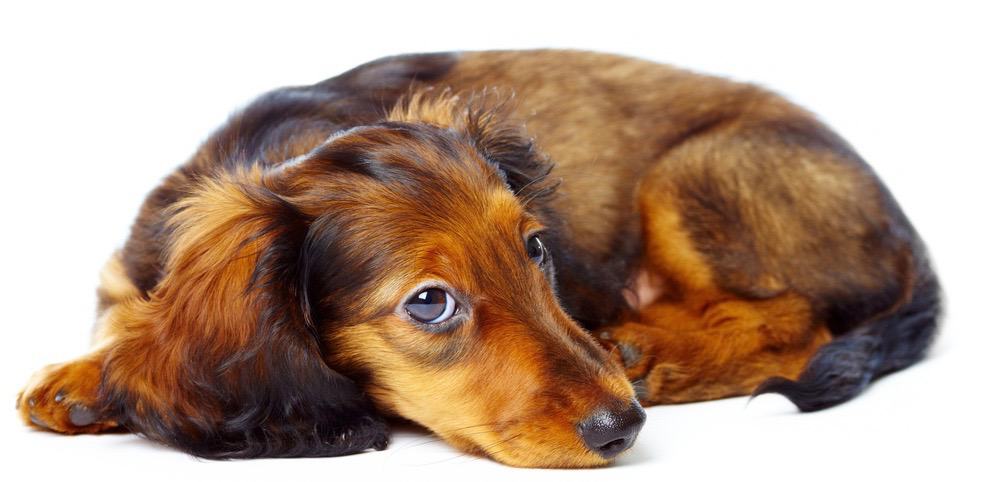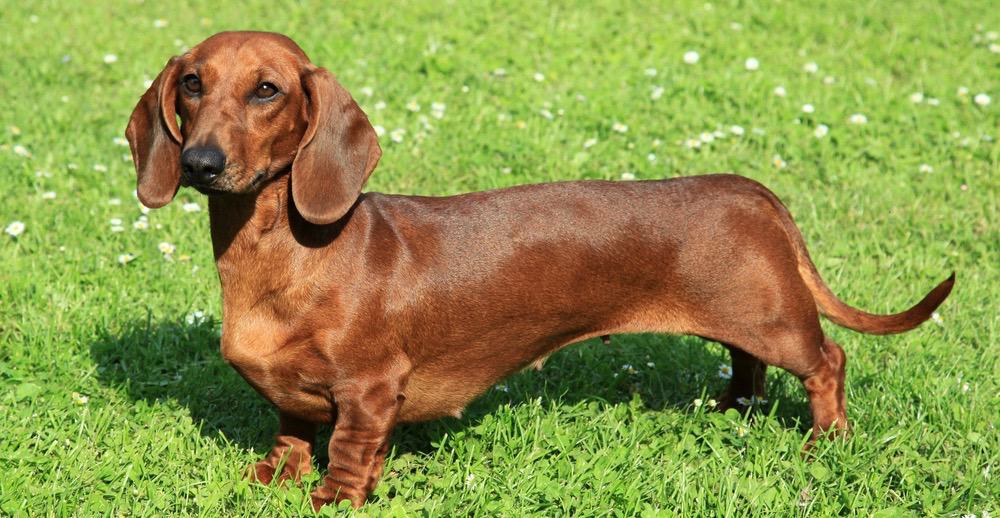Dachshund Growth Chart (Weight & Size Chart) – How Big Do Dachshunds Get?
Dachshunds are determined and intelligent dogs with vivacious personalities. They are small but can be fierce in protecting their domain and enjoy a quest for hunting. They can be standard or miniature.
Are you wondering whether your dachshund is still growing or is overweight? Or have they reached their optimum weight and height?
This article is going to answer your questions and give you more information about the Dachshund growth chart.
When Do Dachshunds Stop Growing?

Dogs like humans have growth plates that close when they are fully grown at a certain age. For some owners, it can be difficult to know exactly when do dachshunds stop growing?
The growth plates for dachshunds occur between the ages of 6 and 8 months and at this point, by following a dachshund weight chart you can know how large your puppy will be.
Dachshunds can still look like a puppy, with features such as a round face, soft fur on the coat, and a narrow chest even when they are fully grown. However, they will stop growing at the age of 2 years.
Another way to know whether your puppy is fully grown is to have a look at their siblings and parents if you can.
You will get a great view of your puppy’s future physique by looking at the previous litter from the same parents.
Dachshund Size Chart
To know the ideal weight for your dachshund, you first need to determine what type you have. Miniature dachshunds are smaller with a height of between 5 to 6 inches and their optimal weight should not be more than 11 pounds.
Standard dachshunds have a height of between 8 and 9 inches weighing around 16 and 32 pounds.
Since standard and miniature dachshunds are of the same breed, it can be hard to know what your puppy will look like when they grow.
However, a 5 or 6-month-old standard dachshund should weigh between 22 and 25 pounds while the miniature dachshund of the same age should weigh between 11.5 and 12.8 pounds.
You can relax if your Dachshund’s weight is a bit more or less than any of the numbers in the chart. If he has a few extra pounds over the stated range it is perfectly acceptable, not all Dachshunds may fall within the established range.
It is advised that you always check with your veterinarian if you ever have doubts.
Dachshund Weight Chart
| Age | Standard Dachshund Weight (lbs) | Standard Dachshund Weight (kg) |
|---|---|---|
| 3 Months | 13 lbs | 5.9 kg |
| 4 Months | 18 lbs | 8.2 kg |
| 5 Months | 22 lbs | 10 kg |
| 6 Months | 25 lbs | 11.3 kg |
| 7 months | 27 lbs | 12.2 kg |
| 8 months | 29 lbs | 13.2 kg |
| 9 months | 30 lbs | 13.6 kg |
| 10 months | 31 lbs | 14.1 kg |
| 11 months | 32 lbs | 14.5 kg |
| 12 months | 32 lbs | 14.5 kg |
Dachshund Growth Chart – What to Expect

Birth – 2 Weeks
From when they are born to 2 weeks, dachshunds are at their most vulnerable stage. In their first two weeks of life, they depend on their mother to feed them, keep them warm and help them urinate.
It is recommended that at this stage, you avoid human interference and let the mother do her job. At this stage, the puppies learn to crawl and walk as well as develop their hearing abilities and open their eyes.
3 Weeks – 12 Weeks
This is also known as the socialization stage. During this period, your puppy will start interacting with other dogs as well as humans around them. It is important to allow your puppy to learn about human interactions.
At this stage of life, your puppy should still be with their mother so that they can develop playing skills and become more coordinated. You will notice that their ears stand up and they develop their ability to bark. Consult a dachshund growth chart to monitor progress.
4 Months – 6 Months
At this stage, your dachshund will start increasing their confidence and independence. They will have increased interest in the world and start venturing further into other things apart from you.
They will not be fully independent hence they are easily distracted. Their progress can be easily monitored against a dachshund puppy weight chart.

They will still have most of their confidence in you and still listen to you, even though they do not fully understand you. Also, in this stage, their size and appetite will be growing almost every day, therefore, make note of all the changes until it reaches the peak.
7 Months – 12 Months
Your puppy enters their adolescent phase, and they will experience changes in temperament. Their need for activity and companionship increases and they will have a low tolerance for boredom.
You should exercise your dachshund at this stage. Exercise ensures that joints and muscles have healthy growth by reducing the growing pains.
Adult
From the age of 12 months and above, your puppy should be fully grown and close to their emotional level of maturity, reaching their ultimate size.
Their final features of the face should start solidifying and if they have been neutered or spayed, their temperament begins to calm down.

Certain parts of your puppy may still grow such as the face, chest, and legs but the changes will be small. Their size should not fluctuate much.
How Big Do Dachshunds Get?

You likely already know that Dachshunds are not very big dogs, but how big do Dachshunds get? The first place to consult and get your information is a Dachshund size chart. These are an excellent reference tool.
If you have seen the puppy’s parents, you probably already have a good idea how big your dog will wind up.
Paw size is another clue, but it is less likely to be obvious with a Dachshund since they have smaller paws and do not grow into them. Finally, you can use a DNA test to look at the pup’s genes for size clues.
Will Neutering/Spaying Affect My Dachshund’s Growth?
If you have ever owned a puppy before, you might be remembering having the pup spayed or neutered around the 6-month mark.
This used to be the standard practice, but in recent years, it was shown that there is a growth risk if a dog is sterilized too young.
In large breeds, research has shown that they have joint growth issues when spayed or neutered too young.
As a Dachshund is not a large breed, it might not affect them at all. It is still a good idea to get them fixed as soon as possible to prevent bad behaviors and accidental pregnancy.
Dachshund Height Chart
While growth charts often help you out with weight, you also might want to consult with a Dachshund height chart to know where your dog is on the height spectrum.
To use a height chart, match up your puppy’s age with the average height and see where his height is at when compared to the averages.
Since the breed is not very large, you should not be surprised to know that they only stand between 8 and 9 inches tall on average, as adults.
Puppies will be even shorter. They stop growing in height between 6 and 9 months normally as well.
How To Properly Weigh And Measure A Dachshund?
It is really easy to properly weigh and measure your Dachshund. When you take your dog in for vet visits, you will definitely get to have your dog weighed and measured. At home, there are other ways you can do it.
Since the dog is small, you can use your bathroom scale to weigh your dog. You can do this by weighing yourself first and jotting that down.
Then, pick up your pup and stand back on the scale. The difference in weight is your puppy’s weight.
To measure your dog’s height, measure the distance from his shoulder to the floor using a tape measure.
What Is A Dachshund’s Neck Size?
You might not have thought about measuring your dog’s neck before, but it is helpful to know. If you know your dog’s neck size, you can buy an appropriate harness or collar.
You can do this with a tape measure, measuring around the point above the shoulder where the collar will rest.
A Dachshund’s neck usually measures between 16 and 20 inches, but naturally, a puppy’s neck will be smaller.
If you are getting a collar for your puppy, make sure the collar will fit, but that it will adjust as he grows, so you do not have to continually buy new, bigger ones.
Factors That Affect Dachshund Puppy Growth

Genetics
Genetics plays an important role in the health of dachshunds. They have a unique body type that sits incredibly low on the ground and is quite long with short legs.
This body structure increases the risk of genetic health issues associated with dogs with long bodies.
The common health issues include back disease, obesity, dental disease, cardiac disorders, and cancer. It is important to visit the vet for a regular check-up to avoid these health conditions.
The dachshund puppy growth chart should always be used as an easy guide to check the expected weight of your pup.
Nutrition
Since dachshunds are prone to obesity, nutrition plays an important role in their overall health. Feeding your Dachshund puppy an unhealthy and imbalanced diet can make them gain weight and become obese.

Therefore, ensure that the food that you feed your dachshund is of high quality and balanced to avoid weight-related health conditions.
Physical Activity & Health
Due to their body type, dachshunds can easily gain weight hence a need for regular physical activity to keep them fit, healthy and happy. Apart from being fit, playing and exercising also encourages mental stimulation.
This prevents your puppy from being destructive, barking excessively, and getting bored.
The minimum requirement for an adult miniature dachshund is 30 minutes of exercise and for an adult, standard miniature is 60 minutes of exercise. However, if you are worried about your puppy’s weight you can increase the exercise time.
Miniature Dachshund vs Standard Dachshund
Are you wondering whether your dachshund is a miniature or standard? The main difference between the two is size: standards are bigger than miniatures.
Standards are 8 to 9 inches to their withers while miniatures are 5 to 6 inches to their withers.
To check the size of your dachshund, use a measuring tape and measure from the floor to the highest point between their shoulder blades (withers).
Put your miniature on the scale too, if they are 5 kg or less, they are a miniature, and if between 7 kg and 14 kg, then they are a standard dachshund.
Both standard and miniature dachshunds have similar coat types, either wire-haired, smooth, or long-haired. The colors of the coat can be black and tan, chocolate and tan, chocolate and cream, cream and red.
How Much Should A Dachshund Weigh?
It is important to know the healthy weight of your dachshund. An overweight or underweight puppy has a higher risk of health issues. So how much should a Dachshund weigh then?
At full size, a standard dachshund should weigh between 16 and 32 pounds while a miniature dachshund should weigh less than 11 pounds, depending on body length and height. You should be able to feel the ribs of a healthy dachshund with your hand and their waistline should also be visible.
Regularly weighing your dachshund is a great way to track whether they are losing or gaining weight.
The following are the signs that your dachshund is overweight:
- You cannot see much definition throughout their body.
- You cannot feel their ribs.
- They are tired and slow.
- Their withers have fat rolls.
- They are in their older years.
- They are not eager to play.
If your dachshund needs to lose weight, do the following:
- Your puppy may be gaining weight because they have a medical condition, therefore, visit the vet for them to be checked out.
- Cut back on the treats. However, if you are training them, replace treats bought from the stores with healthy snacks such as cauliflower or raw carrots.
- Avoid feeding them human food as it increases the risk of diabetes.
- Increase their daily exercise.
How Long Are Dachshunds Pregnant?
On average, the gestation period of dachshunds is around 63 to 65 days. During this period, nutrition and exercise are especially important to maintain the health of the puppies growing and the mother.
A balanced and high-quality diet, as well as regular walks, are necessary during this stage. You should not feed mineral supplements or vitamins to your pregnant dachshund to avoid hormonal imbalance.

Early signs of pregnancy include enlarged nipples and eating more than usual. During the final days of their pregnancy, your puppy will experience rapid weight gain and swollen belly. Once you notice these signs, take your puppy to the vet for diagnosis.
How Many Puppies Do Dachshunds Have?
Dachshunds can also be called badger dogs or sausage dogs and they are not particularly a bigger breed of dogs.
Miniature dachshunds have a lower number of litters of up to four while their standard counterparts have an average litter size of between four and eight.
The litter size can be affected by size and age. Larger dogs have more space for gestation and delivering more puppies compared to smaller dogs.
Younger dogs produce more puppies than older dogs. Dogs should be at least 3 years old and not more than 5 years, to make sure they are fully developed to produce puppies.
What is the Life Expectancy Of Dachshunds?
Is your dachshund beginning to age or getting older? Or do you just want to know their life expectancy? Generally, dachshunds are known to live longer compared to other dog breeds, and many owners have reported that their dachshunds have lived for over 18 years.
Dachshunds and other small dogs like Chihuahuas and Shih Tzu live longer because of their small size.
Larger dogs tend to age quickly because they grow faster which can lead to abnormal growth of tissues causing health problems such as cancer and tumors.
On average, standard dachshunds live between 12 and 14 years while miniature dachshunds live between 12 and 16 years.
How Much Does It Cost To Own A Dachshund?
Before deciding to get a dachshund, you should know the cost involved in owning one. The average cost of owning a dachshund puppy can range from $950 to $1600.
You will need to vaccinate your puppy against diseases such as hepatitis, parvovirus, canine distemper, and leptospirosis. These costs vary between $50 and $80.
You will also need to buy the following items for your puppy which can cost around $550:
- Water and feeding bowls.
- Bedding, for example, vet-bed or bean bag.
- Collar and lead with name tag and contact details.
- Grooming equipment such as comb, brush, nail clippers, dog toothpaste and toothbrush.
- Indoor crate.
- Third-party insurance.
- Poo bags.
The main regular expense is food and treats, and this varies depending on the brand but ranges between $55 and $70 per month. Healthcare insurance is another cost that you need to consider for your dachshund which is around $500 annually.
Dachshund Genetics And Common Health Problems

The common health problems that dachshunds are genetically predisposed to include:
- Intervertebral Disk Disease – This condition happens when the vertebral disks herniate because of too much stress due to their short rib cages, long bodies, and short legs. This disease can be avoided by ensuring that your puppy does not jump up and down and supports its whole body when carrying them.
- Unitary Tract Infection – It is important to monitor your dog’s bathroom behavior and urine. If your puppy does not produce much or finds it difficult to urinate, they may have contracted this infection. It is recommended that you visit your vet for diagnosis and treatment.
- Weight Issues – dachshunds are prone to obesity and excessive weight gain, which can lead to other diseases including heart disease and diabetes. If exercise and diet do not help with your dog’s weight, they may have thyroid disease that manifests as lethargy and infection.
Final Thoughts
Hopefully, the above article has given you information to better understand the dachshund weight chart, as your dachshund pup grows and develops. This will help you maintain their optimum weight throughout their stages of life.






